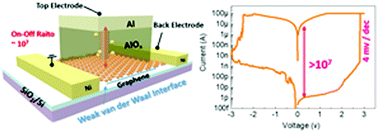Dimensionally anisotropic graphene with high mobility and a high on–off ratio in a three-terminal RRAM device†
Abstract
In the past decade, graphene has aroused worldwide academic passion in the electronics community, due to its unique two dimensional lattice structure and high mobility properties. Meanwhile, the utilization of graphene for next-generation nano-electronic materials is still under debate due to its intrinsic zero band gap nature. To meet the requirement of logic applications, diversified academic attempts have been carried out to modify its intrinsic band structure, such as doping, bilayer stacking, nano-patterning, or heterostructures. In this work, a tailor made strategy for graphene is proposed and experimentally demonstrated: a dimensionally anisotropic graphene based three terminal resistive random-access memory (RRAM). This device could be operated in two modes, which realized not only high carrier mobility (103 cm2 V−1 s−1) and low gate leakage in field effect mode, but also a high on–off ratio (107) and ultra-low off state current (1 pA) in resistive switching mode. This device also exhibits high reliability in logic data storage: long retention up to 8000 s, endurance of 400 DC operation cycles, and read immunity up to 1 million cycles. To guarantee the dimensional uniformity and high quality of the graphene, surface polishing and passivation techniques were carried out on Cu foil before graphene CVD synthesis. As demonstrated in this study, the current work paves the way for graphene toward practical logic and memory applications with high performance and low steady state power consumption.



 Please wait while we load your content...
Please wait while we load your content...